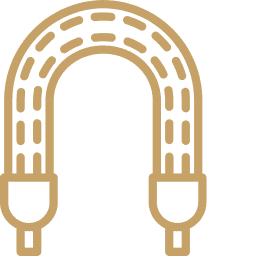Can you play an acoustic guitar through an electric amp? Can you run it through effect pedals? You bet you can! Should you do it? Well, we’ll let you decide…
Be sure to subscribe to our YouTube channel to keep up with more great videos like this one:
Transcription
If you play heavy music or you tune your guitar way down from standard, you’re probably used to using a lot heavier of guitar strings then your guitar might have been designed for. You’ve also probably wondered at some point, how heavy of strings could you put on your guitar before it would cause you some issues. Whether those are at the tailpiece or the bridge, or the nut or the tuning peg.
Today we’re going to test it and see how heavy of a string we can use on this little Epiphone 339 which was almost certainly not designed for extra heavy strings, but I have a feeling we’ll be able to make at least some of them work.
I’m going to start off with a 60. In my experience gauges less than 60 are generally okay on almost any guitar, unless you have some more niche-y issues like a titanium bridge that will only accept a 56 or something like that, but for today’s purposes, we’re going to start with that 60. We’re going to see at what point we start to encounter any issues with the tailpiece, the bridge, the nut or the tuning peg.
First off, I have a 60 right here. Let’s see what happens. Not any problem with the tailpiece at all, which I didn’t expect there would be. Not any trouble with the bridge. It might be just slightly too heavy for the nut. I might want to widen that a little bit if I was setting up this guitar to go with a string like this full time, but that said, it’s not too bad. It’s just a little bit on top of there. I would definitely look at that, but here’s what I really want to look at. The tuning peg. All right. Not a problem at all on the tuning peg. That fits through just fine. We even got some room there. I’m not going to tighten these up just for the interest of time, we’re going to see if they’ll fit on just like this and that’ll tell us most of what we need to know.
Next up we have a 62. Interesting thing about these is this is gauge at which we start to use a compound wrap. What that means is that instead of just having one gauge of wrap wire going around the core wire, we have multiple gauges, so they combine to give us that overall diameter of .062 instead of us going with a really, really thick core wire, or a really thick wrap wire. What that does is, it makes the string play a little bit better, be a little bit more slinky then you would see with an extra, extra thick core wire or something like that.
All right. Again, no problem at the tailpiece at all. Just fine at the bridge. We already know that we’re not going to perform too well at the nut without a little bit of minor tweaking there, just because that 60 didn’t, but no problem at the tuning peg, so a 62 again, would be no problem here for this 339.
Next up we have a 64. This is a really common gauge for seven string sets. For six string sets, its usually people going even heavier than drop C, like drop B or drop A, which we do get a lot of. If you like things fairly slinky you can maybe even make it work at drop G. All right, no problem at the tailpiece. Not a problem at the bridge. Let’s see what happens up here at the tuning peg. All right, we got through, but it’s starting to get a little tight. So a 64 would be no problem, but once we make the jump up to the 68 next, that’s where it’ll get interesting.
All right, now is the real test. We have a 68, which is a darn heavy string for a six string, but it’s been done. This would probably be a gauge for drop A, or drop G, most commonly, just depending on how slinky you like it. You could use it for drop B if you really liked your strings rather tight, but I think it’d be a quite a bit there. All right, no problem at the tail piece. No problem at the bridge. Now is where I’m starting to get a little bit nervous. Let’s see what happens up here at the tuning peg. We’re through. Not a problem. All right, so a 68 is also good.
All right, working our way up, we now have a 70. Let’s see what happens. Sorry these ones are a little bit harder to uncoil because the core wire is getting a little bit thicker, bit by bit. All right. Nope not a problem for the tailpiece. Seats in there just fine. The bridge is fine. Let’s see, Not a lot of room there in the tuning peg, but we can pull it just fine through. I’d say a 70’s also good for you.
All right, now it’s getting really interesting. We are up to a 72 which is a somewhat light lowest string on an eight string set, but I think it might work. I don’t know, we had a little bit of room left on there with the 70. This is also the point at which we start to taper our ball ends. The reason for this, it looks a little bit, almost unfinished or something like that, is because when you wrap the outer wrap, around this inner twist, especially with multiple wraps, a lot of times you can get this very thick knob at the bottom near the ball end and that can cause some issues fitting through some bridges. On this tune-a-matic, it would probably be okay, but on Steinberger style guitars or Steinberg guitars, it can cause some issues, but as you can see, it fits right over there over the bridge just like normal and doesn’t cause any issues at all. It just makes it so you don’t have any issues on any tail pieces. Let’s see what happens up here. Can it do it? It can do it. All right. So a 72 is also totally fair game.
All right, next up we have a 74, which is the last gauge I grabbed, but I can go downstairs and grab an 80 if this one passes. I actually thought we might make it to 70. I wasn’t sure on this guitar if we’d be able to get heavier than that, but we’ve had no problem thus far, except for the nut of course. All right. No problem on the tail piece and we’re actually through the tuning peg on a 74. This is the low F sharp on a lot of eight string gauges. I don’t think you would expect that it would fit on a standard tuning peg, but at least on these Epiphone style tuning pegs it works just fine.
All right, I had John who runs camera for us run down and grab us a few more gauges because they’re still fitting. Let’s see what happens when we jump to an 80 gauge. Currently this is the next heaviest gauge we make. As it gets heavier, smaller differences like .002 mean a little bit less, so at a certain point, our gauges get a little bit wider between two different gauges that we offer, like from 74 to 80, or 80 to 85. Let’s see what happens. All right, so finally we encountered a string that is too wide for our tuning peg. An 80 in this case wouldn’t work.
There are a few options if you do want to use something like an 80 on a guitar with a tuning peg that won’t fit it. The easiest thing to do is to have a tech use a very small drill or other means of widening your tuning peg just slightly. There’s a lot of meat on your tuning pegs and those holes can be expanded without it causing any sort of issues for the performance of the peg or anything like that. The other option, if you’re just using it one time, is to clip the string just a little bit past the length that you need and use a pair of needle nose pliers to unwrap the outer wrap and string the core wire right through the tuning peg. Won’t cause any issues for the performance of the string, it’s just a little bit of tedious work. In general, I would recommend having a tech fix it for you so you don’t have to worry about it in the future.
What have we learned today? Well, we learned that you can use up to a 74 gauge string on at least an Epiphone tuning peg without any trouble. My gut is that it’d be fairly similar on a lot of other mainstream tuning pegs and you can use actually a pretty heavy string without coming into any trouble there. We did also learn that you’re going to have to do some widening of the nut. This again depends guitar by guitar how it’s set up, but in a lot of cases, once you get over something like 52 or 54, you might have to just slightly widen that, but again, just a little bit of very fine grit sandpaper and you’re going to be off to the races.
Now if you don’t tune down or really, really low, you might be wondering why anybody would ever need a string that thick on a six string guitar, but if you’re tuning down to things like F sharp, you really, really need a heavy string. Something like a 74 would be a great option for you, so it’s good to know that you can use a 74 with just a little bit of work on the nut without a problem, even on a guitar just like this Epiphone Hollow Body that was definitely not set up for it.
I also have a lot of guys ask me when they’re using really, really heavy strings if it’s bad for the neck of the guitar. The thing that you have to understand is tension is a mixture of the gauge or mass of the string and what you’re tuning it up to. If you’re tuning way, way down and you’re using really heavy strings, it’s not necessarily going to have any more tension than a set of 10’s in standard, but if you’re tuning something like a 74 on the bottom to the E of a standard tuning, that’s going to be a lot of tension and that’s going to be bad for your neck. The important thing is to just always ensure that your matching where your tuning is and what your scale length is, with the gauge of strings that you’re using. We can be a really great resource for that. I encourage you to hit us up at [email protected].
If you have any questions, just let us know what tuning your using, what scale length your using and what gauges you’ve typically used in the past and we’ll help you find the gauge of strings that’s going to work really well for you.
What do you think? Have you tried really, really heavy gauge strings on different guitars and found the point at which they no longer work? Let us know down in the comments, I would love to hear how it varies from guitar to guitar. We have tested a lot of different guitars here and in general, for us, up to about a 70, it’s not usually a problem. Some very old vintage style Fender tuners, those can get a little tricky after something like a 52 or 54, but it just depends on what tuner your using, and in almost all cases, no matter what, you can get a little bit of work done to your guitar and you’ll still be able to put as heavy of a string as you really want on there without too much trouble.








